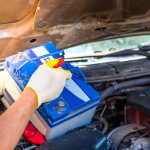Driving at night can be a daunting task for many, as reduced visibility and unique challenges can create a less-than-comfortable experience behind the wheel. However, with the right techniques and precautions, you can navigate the darkness with confidence and safety.
In this article, we will share essential tips for driving in the dark, helping you to enhance your awareness, improve your skills, and ensure that every nighttime journey is as smooth as possible. Whether you’re commuting home after a long day or embarking on a late-night adventure, these friendly and practical suggestions will empower you to conquer the roads, no matter how dimly lit they may be. So, buckle up and let’s illuminate the path to safer nighttime driving!
Table of Contents
- Preparing Your Vehicle for Nighttime Journeys
- Mastering Your Headlights for Optimal Visibility
- Navigating Road Hazards and Reducing Glare
- Enhancing Your Awareness and Confidence Behind the Wheel
- Q&A
- In Retrospect

Preparing Your Vehicle for Nighttime Journeys
When , it’s essential to ensure that all aspects of your car are functioning optimally to enhance safety and visibility. Start by checking your headlights, taillights, and turn signals to make sure they are bright and free from any obstructions like dirt or grime. A quick inspection of your vehicle’s windshield wipers and the wiper fluid is also crucial, as clear visibility during rainy or foggy conditions can help prevent accidents. Additionally, ensure your tires are properly inflated and have ample tread to maintain control on darker, potentially slippery roads.
Another critical aspect of nighttime driving preparation is adjusting your vehicle’s interior settings for comfort and ease of use. Consider dimming your dashboard lights to reduce glare, which can impede your night vision. It’s also wise to have essential items within easy reach. Here’s a quick checklist of items to keep handy:
Flashlight – for emergencies
First aid kit – always a smart precaution
Emergency blanket – useful in unexpected situations
Phone charger – to ensure connectivity
Mastering Your Headlights for Optimal Visibility
Ensuring your headlights are functioning at their best is crucial for safe nighttime driving. Regular maintenance is key; check your bulbs periodically and replace them as soon as they begin to dim. Remember that headlight alignment can significantly impact your visibility. If your lights are aimed too low, you won’t illuminate the road ahead, while headlights aimed too high can blind oncoming drivers. To check alignment, park your vehicle about 25 feet from a wall, and ensure the top of the beam hits the wall at around the same height as the center of your headlights.
Additionally, consider upgrading to high-quality bulbs that offer brighter and whiter light. This not only enhances your visibility but also helps you see road signs and potential hazards more clearly. When driving in adverse weather conditions, such as rain or fog, switch to your low beams to reduce glare and improve clarity. Creating a habit of cleaning your headlights regularly can also make a significant difference, as dirt and grime can diminish their effectiveness. Here’s a simple table to help you remember essential tips for headlight care:
| Tip | Description |
|---|---|
| Check Bulbs | Inspect and replace bulbs showing signs of dimming. |
| Align Headlights | Ensure proper alignment for maximum visibility. |
| Upgrade Bulbs | Choose brighter, higher-quality options for enhanced illumination. |
| Regular Cleaning | Clean headlights to prevent dirt buildup that reduces light output. |
Navigating Road Hazards and Reducing Glare
Driving in darkness presents unique challenges, especially when it comes to spotting road hazards. To enhance your visibility and reaction time, keep your headlights clean and properly aimed. Always scan the road ahead and utilize your peripheral vision to catch any sudden movements or obstacles. Here are a few tips to help you navigate safely:
Stay Alert: Fatigue can impair your judgment, so be mindful of how tired you feel.
Use Your High Beams: When no other vehicles are around, high beams can illuminate the road more effectively.
Adjust Your Speed: Reduce your speed to give yourself more time to react to unexpected hazards.
Glare from oncoming headlights can be disorienting and dangerous. To combat this, consider wearing polarized sunglasses to reduce brightness and improve visibility. Position your rearview mirror to minimize glare and keep your windshield clean to prevent distortions. Here’s a simple strategy to tackle glare:
| Situation | Tip |
|---|---|
| Oncoming Traffic | Focus your gaze towards the right side of the road. |
| Following Vehicles | Adjust your mirror to a position that reduces reflections. |
| Streetlights | Drive at a comfortable speed, allowing your eyes to adjust. |
Enhancing Your Awareness and Confidence Behind the Wheel
Driving at night can be a daunting experience for many, but with the right practices, your confidence can soar as you navigate the darkened roads. Begin by ensuring your vehicle is in optimal condition; check your headlights, brake lights, and taillights to guarantee they are functioning properly. Keeping your windshield clean and free of obstructions will enhance visibility, allowing you to spot pedestrians, cyclists, and other vehicles more easily. Additionally, remember to adjust your mirrors for a broader view and avoid being blinded by oncoming traffic by utilizing the day-night mirror setting effectively.
Being aware of your surroundings is crucial when driving after sunset. Here are some essential tips to enhance your situational awareness:
Reduce Speed: Slower speeds improve reaction times and increase the distance you can see ahead.
Use High Beams Wisely: Use high beams in unlit areas but switch to low beams when approaching other vehicles.
Look Ahead: Scan the road for hazards that may not be immediately visible.
Avoid Distractions: Keep your focus on the road—limit phone use and conversation.
Additionally, being proactive about fatigue can dramatically impact your alertness. Making sure you are well-rested before driving is essential to maintaining focus. In situations where you feel tired, consider taking breaks or sharing driving duties if possible. Here’s a simple table to summarize effective techniques for nighttime driving:
| Technique | Description |
|---|---|
| Pre-Drive Check | Inspect lights and mirrors. |
| Speed Control | Adjust speed to increase reaction time. |
| Environmental Awareness | Stay alert to the surroundings and potential hazards. |
| Take Breaks | Rest to avoid fatigue during extended night drives. |
Q&A
Q1: Why is driving at night different from driving during the day?
A: Driving at night poses unique challenges due to reduced visibility and the presence of oncoming headlights. Your depth perception, peripheral vision, and overall reaction time can be compromised in the dark. Additionally, fatigue is often greater at night, which can affect your focus and decision-making skills.
Q2: What are some essential tips for improving visibility while driving at night?
A: To enhance visibility, make sure your headlights are properly aligned and clean. Use your high beams in dark areas when there’s no oncoming traffic, but remember to switch to low beams when you see other vehicles. It’s also a good idea to keep your windshield and windows clear to avoid glare and improve your overall sightlines.
Q3: How can I reduce the risk of glare from oncoming traffic?
A: To minimize glare, you can adjust your rearview mirror to the night setting, which dims the reflection of headlights. Additionally, avoiding looking directly at oncoming lights can help; instead, focus your vision towards the right edge of your lane to maintain awareness of the road.
Q4: What should I do if I feel tired while driving at night?
A: If you start to feel fatigued, pull over as soon as it is safe to do so. Take a short break, stretch, or even grab a snack. If possible, consider switching drivers or finding a safe place to rest until you feel more alert. It’s always better to arrive late than to risk an accident.
Q5: Are there any specific road conditions I should be wary of at night?
A: Yes, certain conditions tend to be more hazardous at night, such as wet or icy roads. Watch out for animals crossing the road, as they’re harder to see. Additionally, be cautious of construction zones or areas with limited lighting, and always obey road signs, as they might be difficult to spot in the dark.
Q6: How can I prepare my vehicle for nighttime driving?
A: It’s wise to perform a quick check of your vehicle before hitting the road at night. Ensure that your headlights, taillights, and brake lights are all functioning. Keep your gas tank at least half full to avoid running out in remote areas and check that your tires are in good condition for optimal traction.
Q7: What should I do if I encounter an emergency on the road at night?
A: If you encounter an emergency, safely pull over to the side of the road, activate your hazard lights, and stay inside your vehicle if it’s safe. If you need to exit the vehicle, be cautious of traffic. Utilize your phone to call for help and remember to stay calm until assistance arrives.
Q8: Are there any technological aids that can help when driving at night?
A: Absolutely! Many newer vehicles are equipped with advanced technologies like adaptive headlights, night vision systems, and lane departure warnings that can be very helpful. Additionally, GPS and navigation apps can provide real-time traffic updates and alerts for road conditions, making your nighttime journey smoother and safer.
Q9: What’s the best mindset to maintain when driving at night?
A: Maintaining a calm and focused mindset is crucial when driving at night. Stay alert, anticipate potential hazards, and drive defensively. Avoid distractions such as loud music or mobile devices, and remind yourself to take deep breaths and relax. A confident driver is a safer driver.
By following these tips, you can navigate the roads comfortably and safely, ensuring an enjoyable nighttime driving experience. Happy travels!
In Retrospect
driving in the dark can undoubtedly present its own set of challenges, but with the right approach and precautions, you can ensure a safe and confident experience on the road. By maintaining your vehicle’s lighting, adjusting your driving habits, and staying aware of your surroundings, you can navigate nighttime journeys with ease. Remember, practice makes perfect; the more you familiarize yourself with driving after sunset, the more comfortable you will become. So, the next time you find yourself behind the wheel after dark, trust your instincts and utilize these tips to enhance your safety. Drive smart, stay alert, and enjoy the freedom that comes with exploring the world, even when the sun goes down. Safe travels!











